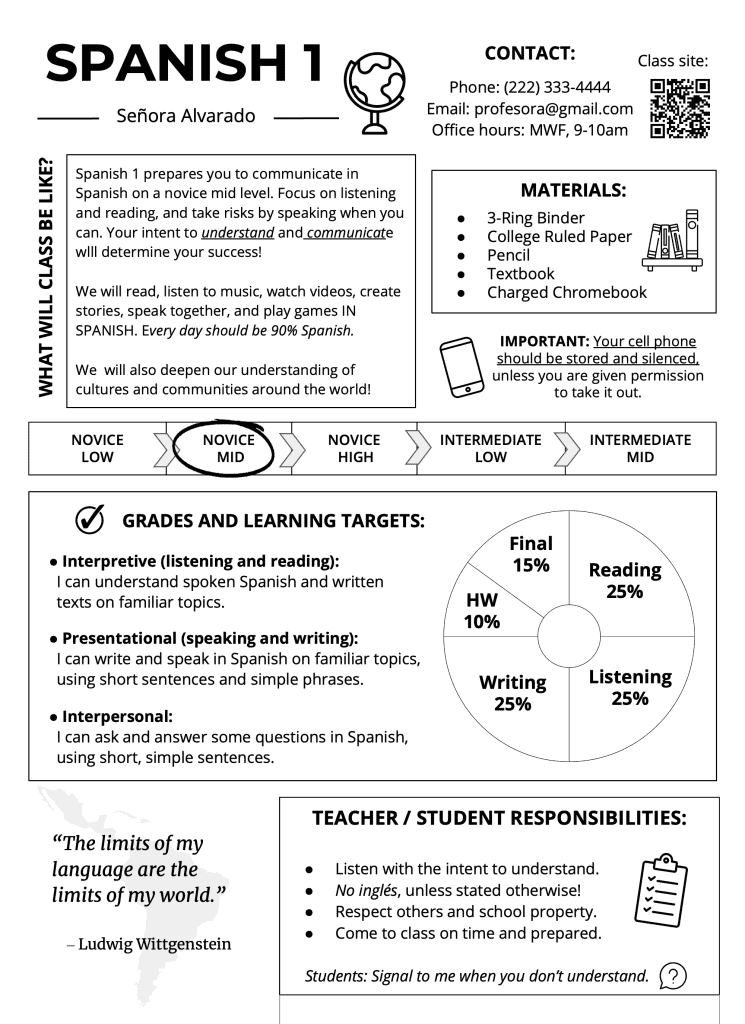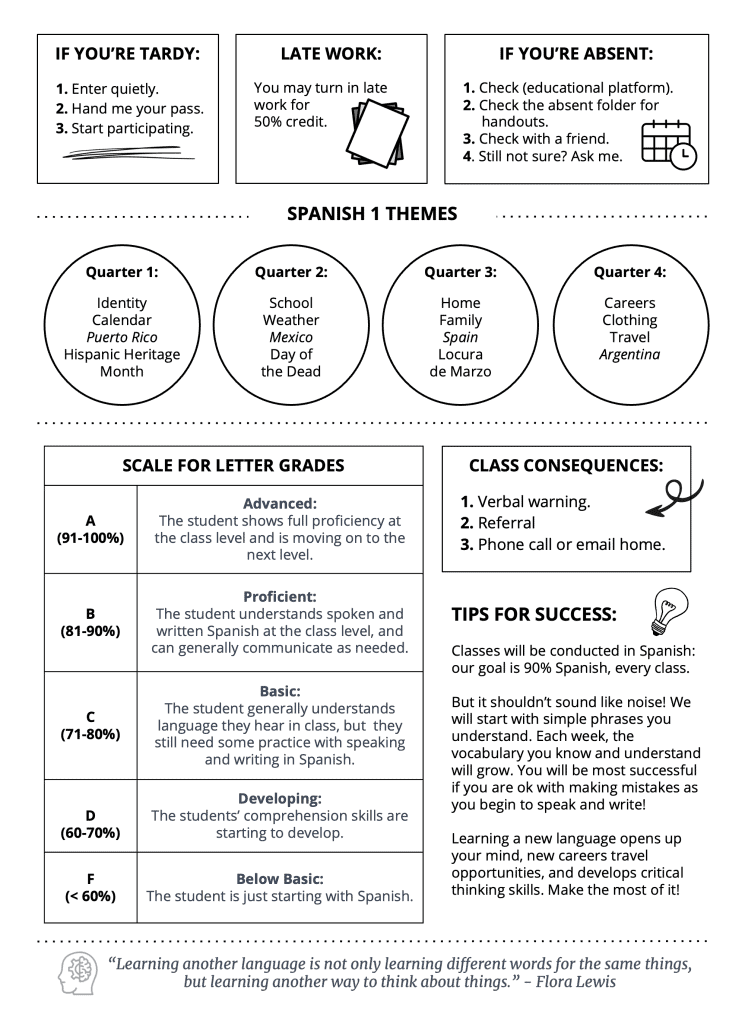A Guide to Creating Your Spanish Syllabus
Inside: Examples of a Spanish 1 Syllabus and a guide for what to put in yours!
Let’s be real: most high school students are not going to pour over your syllabus and appreciate your hard work making it pretty.
In fact, I don’t recommend using your precious class time that first day to read every word of the syllabus (see these better first-day ideas instead!).
BUT– most schools ask for one, and it’s the best way to get all of your core information set down into one place. You can hand out your written syllabus the first day, while slowly introducing procedures throughout the first two weeks. (As in, Day 1, you teach everyone how to enter/exit. Day 2, explicitly lay out what respectful listening looks like, etc.)
A clear, concise Spanish syllabus is very helpful to the students who want all of that info upfront, and it’s a good cover-your-ahem to have your policies clearly laid out from the get-go. Bonus points if you have your students/parents sign them!
World language classes can differ from other core subjects like math or history, so it’s helpful to give them an idea of the class goals and expectations.
Let’s take a look at the main components of a Spanish course syllabus and see some examples!
Contents:
Examples of a Spanish Syllabus
1. Contact
2. Attendance
3. Materials
4. Course Objectives
5. Grading Scheme
6. Curriculum
7. Procedures
8. Classroom Policies/Rules
9. Other
Syllabus Examples for Spanish Classes
Most of are probably just looking for examples to see it all laid out visually! Here’s an example I made:
Here are a bunch of example syllabi that I gathered on Pinterest:
What to Include in Your Spanish Syllabus?
Note– I am not suggesting you have to include all of these sections! It’s better to leave off a section than go and change your classroom policy after handing it out to parents and students.
1. Contact Information
Pretty self-explanatory, but be sure to include how you prefer that students contact you and if there is a class website or Google classroom.
You might include a note on your schedule or when you are available to respond to emails (i.e., not on weekends!).
2. Attendance
This is most likely preset by your school, but you may want to include a section noting policies on how absences and tardies are handled.
How you handle make-up work could also go under procedures, but you can set up your policies on late work here, and what students should do or check after an absence.
3. Materials
What do you your students need to bring for classwork everyday? A notebook, binder, pencil, pens, Spanish-English dictionary?
This section is what parents look at first, so be as specific as possible.
4. Course Objectives
This is where syllabi begin to vary quite a bit in foreign language courses. Be as brief as you can, but explain what basic language skills successful students will acquire from your class.
I like to include a quick graphic that shows the different proficiency levels and then a brief description of what that means for the different modes of communication (Ohio has helpful descriptions of the proficiency levels.)
Here’s an example for Spanish 1:
Goal: Students will reach Novice-Mid to Novice-High by the end of Spanish 1.
- Interpretive (listening and reading):
I can understand spoken Spanish and written texts on familiar topics. - Presentational (speaking and writing):
I can write and speak in Spanish on familiar topics, using short sentences and simple phrases. - Interpersonal:
I can ask and answer some questions in Spanish, using short, simple sentences.
If you are following a specific curriculum or textbook, you could be more specific. (I can introduce myself and my family, share some of my hobbies and daily life.) If you are following a more specific grammar approach, you might say something about students communicating about events in the present or past.
I think these are helpful to clarify, as some parents or even admin can lack understanding of what is realistic in a Spanish class. (As in, one year of Spanish does not produce conversationally fluent students!)
In determining the expected proficiency level from your class, here are some references:
- How Many Hours of Instruction Do Students Need to Reach Intermediate-High Proficiency? (From CALS at the University of Oregon)
- Page 12-13 on this document from ACTFL is also helpful in showing how many years of a world language predict what proficiency levels.
- This article also breaks down hours for achieving proficiency by languages.
5. Grades
Explain how your grade book is set up in this section, and what your criteria for evaluation is.
Some teachers set up their grades by communication modes (listening, reading, speaking, interpersonal), while others use a more traditional approach (homework assignments, participation points, quizzes, final exam). I have usually done a combination of those categories.
You can also include a scale or scheme that explains what each letter grade means, percentage-wise (is an A 91% – 100%? Is it 93% – 100%?). If your school using standard-based grading, what do Advanced, Proficient, etc. mean?
Some references if you are determining your grade book setup and would like some help with your wording:
- Proficiency Rubric from Martina Bex
- Proficiency Based Grading from Señora Chase
- Grading and Reporting Schemes from Magister P
6. Course Overview
This could include what themes or books will you use. I taught without a textbook most years, but I still liked to include a basic outline of the year’s units and what novels we would be reading in class.
Also, you may want to do a more casual “here’s what to expect in class!” course description. Here’s some example phrasing:
“Spanish 1 prepares you to communicate in Spanish on a novice mid level. Focus on listening and reading, and take risks by speaking when you can. Your intent to understand and communicate wlll determine your success!
We will read, listen to music, watch videos, create stories, speak together, and play games IN SPANISH. Every day should be 90% Spanish.
We will also deepen our understanding of cultures and communities in the Spanish-speaking world!”
7. Procedures
Not to be confused with the rules in the next section, consider what procedures you want to have in writing from the outset. Up to you if you want to include these in writing!
These could be:
- How to enter and exit the room
- What to do about missed work in the case of absences
- Bathroom procedures
8. Classroom Policies
Obviously, this one is really important! I think it’s best to have your top polices written down and get a signature on them. Some ideas:
- Cell phone policy
- Academic integrity (use of translators, plagiarism)
- Student responsibilities (respect others and school property, be on time, be prepared, actively listen, etc.)
- Teacher responsibilities (provide comprehensible input, stop and clarify when students signal they don’t understand, come to class prepared).
- Use of the target language
I have a whole post that goes into detail for Spanish class procedures and policies if you need help brainstorming!
A lot of teachers prefer to collaborate with their classes to come up with a mutual agreement on class rules.
Personally, I like to have my general, baseline rules in writing (basically, be respectful of others, of class time, and school property), and then generate specific descriptors of what that means. Respectful listening, for example, might look like one person talks at a time, certain body posture, no sleeping, no phone, etc.
8. Other
Those are my basics personally, but here are some more ideas to consider!
1. Draw from the ACTFL World Readiness Standards for Learning Languages.
Here’s my own student-friendly rewording of their 5 C’s:
- Communication: What you can do in Spanish.
- Cultures: Interact with other culture and ways of life.
- Connections: Think with a diverse perspective in all subjects.
- Comparisons: Understand the nature of language, including their own.
- Communities: Use the target language within and beyond the classroom.
2. Include tips for success.
Here’s some sample wording:
Classes will be conducted in Spanish: our goal is 90% Spanish, every class.
But it shouldn’t sound like noise! We will start with simple phrases you understand. Each week, the vocabulary you know and understand will grow. You will be most successful if you are ok with making mistakes as you begin to speak and write!
Learning a new language opens up your mind, new careers travel opportunities, and develops critical thinking skills. Make the most of it!
3. Benefits of Learning a Foreign Language.
- Cognitive Development:
It makes your brain active and flexible. - Social-Emotional Development:
Speaking more than one language helps you self-regulate and form strong friendships. - Learning Advantages:
Promotes high levels of complex thinking and helps your brain quickly filter information. - Career Advantages:
Speaking another language opens up job and travel opportunities. - Personal Development:
Learning a new language helps you understand both the world and yourself better.
(Sourced from the Department of Education.)
4. Inspirational quotes.
I have a huge post of quote on language learning! Here are five favorites:
1. “The limits of my language are the limits of my world.”
‒ Ludwig Wittgenstein
2. “Learning another language is not only learning different words for the same things, but learning another way to think about things.”
– Flora Lewis
3. “You can never understand one language until you understand at least two.”
– Geoffrey Willans
4. “Do you know what a foreign accent is? It’s a sign of bravery.”
– Amy Chua
5. “A different language is a different vision of life.”
– Federico Fellini













